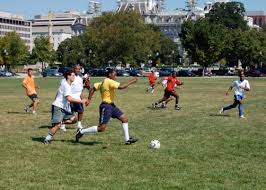Soccer culture is picking up steam in the U.S.

Pick-up games show that more are embracing the sport of soccer
November 20, 2018
On long hot Wednesday summer nights in Fox River Grove, Illinois something happens that forty years ago would not have been imaginable. A group of about 25 people of all different ages show up at a small park connected to the adjoining Algonquin Road School. What happens next is visual proof that there is a soccer culture in the United States: Pick up soccer is played.
Sports pundits often debate whether there a so called soccer culture exists in the majority of the United States. Pick-up sports is the definition of a so called sports culture in the way generations of Americans have grown up with stories that could be right from the movie The Sandlot with baseball and football. Soccer is here to stay and is becoming part of the American sports landscape.
In 2013 NBC started to broadcast the English Premier League in the United States outbidding Fox and ESPN with a whopping $250 million bid. A clear sign of the demand for televised European League soccer in the United States.
Soccer has always been a niche sport in the United States while being the sport of choice almost everywhere else. Soccer in America has always thrived in areas of high immigrant populations, as it did in ethnic neighborhoods in Chicago throughout the 1950s and beyond. In the 1950 FIFA World Cup, the United States with a cast of primarily first and second generation American part time players beat England 1-0 in the first round of the tournament as extremely heavy underdogs, depicted in the 2005 film The Game of Their Lives. The United States was also having limited success on the field in major tournaments taking third in the inaugural World Cup and reaching the quarterfinals of the 2002 World Cup. On the women’s side of the sport the United States has always dominated, winning three FIFA World Cups and several Olympic Gold Medals.
Although the success on the field has not always been evident, viewership has always created a splash. Soccer has become part of the American sport afternoon scene. NBC’s coverage of the English Premier League is centered around Saturday and Sunday morning and early afternoon coverage. A time slot usually not filled by any American sports. Fox Sports jumped on the soccer bandwagon or in this case the “Volkswagen” by purchasing the American broadcasting rights to the German Bundesliga. This year Turner and Bleacher Report gained the rights to the UEFA Champions League and have implemented a partial Pay-Per-View policy on some matches, which has had a mixed fan response. Nevertheless there is more soccer on U.S. television than ever before.
This has allowed for European soccer fanship to rise to new heights in the United States. Practically every major European club has official fan clubs in the United States. Some in major U.S. cities: In 2015 Bayern Munich made the decision to open an United States office in New York City.
When soccer culture in America was just found in ethnic neighborhoods, televised soccer was nowhere as easy to access as today. The German immigrant population of Lincoln Square in Chicago was treated to live soccer at nearby Wrigley Field as the North American Soccer League Chicago Sting played at the Friendly Confines in the 1970s and 1980s — long before the creation and success of Major League Soccer.
Max Niedermayer, a German Immigrant who arrived in Chicago in 1958 attended Chicago Sting games frequently. When asked about the atmosphere of those games played in a baseball park he said: “It was obviously different than a typical soccer \environment-It was just to have a taste of home in Chicago at that point. Now it is super easy to European soccer on American television.”
Today major league soccer continues to expand with additional franchises as three more MLS teams are scheduled to begin play in the next two seasons and reasonably good attendance continues to make MLS a success and some fans and pundits desire to see a relegation system in American soccer with the MLS and lower leagues. This is a telltale sign of growth in the sport.
The 2018 World Cup might have been a turning point for the sport of soccer in the United States. The U.S. National team failed to qualify for the tournament in very embarrassing fashion losing to Trinidad and Tobago on the final night of qualification. The group stage match between Germany and Sweden still drew an audience of 5.4 million viewers in the U.S. Not bad for a sport once thought of non-existence in America.
